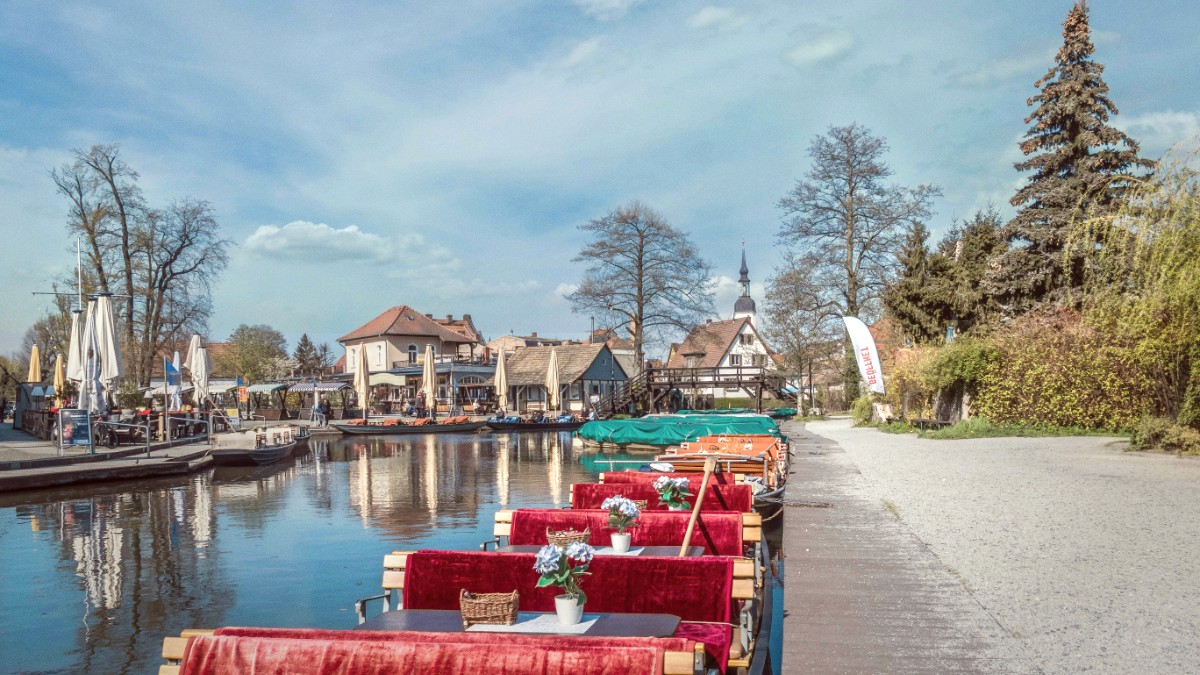
Germany
Explore the Spreewald Canals by traditional punt boat (Kahnfahrt), canoe, or kayak. These canals represent centuries of human interaction with nature. Arrive early for punt tours, especially during high season.
Freilandmuseum Lehde (Spreewald Open-Air Museum) in Lehde preserves traditional Sorbian houses. It illustrates daily life from past centuries, providing insight into the region's cultural heritage.
The Spreewald is not a major art destination, but local art is present.
No prominent archaeological sites or ancient ruins serve as major tourist attractions.
No specific memorial sites or monuments are major tourist attractions. The historical focus is on cultural preservation.
Walk or cycle through Lehde and Leipe to fully appreciate their Sorbian architecture and peaceful canal-side settings.
The region's history highlights continuous settlement and adaptation to its water environment.
Explore the unique church in Straupitz designed by Karl Friedrich Schinkel for its architectural interest.
The entire Spreewald is a natural attraction, recognized for its unique ecosystem as an UNESCO Biosphere Reserve.
The entire region is an UNESCO Biosphere Reserve, functioning as a large, protected natural park. Guesthouses and hotels have well-maintained gardens.
Numerous viewpoints along hiking and cycling trails offer vistas over the canal network, forests, and meadows. Local maps highlight these points.
This picturesque village combines natural beauty with a historic brewery and a nature education center, offering insights into the wetlands.
The biosphere reserve is a haven for otters, beavers, and various bird species (kingfishers, eagles, storks). Best observed from a canoe or during quiet walks.
The entire region is defined by its waterways. Lakes like Spreewaldsee in Lübben offer designated swimming areas and recreational activities.
Rent a canoe or kayak early in the morning for the best chance to spot wildlife in their natural habitat along quieter canals.
The Spreewald is a protected natural park, preserving its unique wetlands ecosystem.
A sanctuary for diverse wildlife, including otters, beavers, and many bird species like kingfishers and storks.
The entire region is shaped by its intricate waterways and numerous lakes, central to its natural appeal.
Beyond the main tourist spots, the Spreewald holds quieter, equally charming places that offer a local experience.
Capture the distinctive beauty of the Spreewald, from its calm waters to its traditional architecture and local life.
The still canals present stunning reflections of trees, houses, and the sky, especially at dawn or dusk.
Photograph the unique architecture of Sorbian houses, often with thatched roofs, nestled by the water.
Document the iconic punt boats as they glide under small bridges or navigate narrow waterways.
Patiently capture photos of kingfishers, otters, or beavers in their natural habitat.
Cycle or canoe on quieter canals that branch off from the main routes. Ask your guesthouse host for peaceful paths.
A punt boat tour is a classic Spreewald experience, but renting your own canoe allows you to explore at your own pace and reach tranquil spots.
Guided tours offer the quintessential Spreewald experience. Choose from various lengths, often with stops at waterside eateries.
Rent your own and explore the intricate canal system independently. Numerous rental stations exist with maps and instructions.
Combine a punt boat tour with a separate day of self-guided canoeing or cycling for diverse perspectives.
Venture beyond Lübbenau to explore smaller, lesser-known villages.
Discover quieter areasCycling naturally leads to quieter sections, providing hidden viewpoints.
Find cycling toursThe nature education center in Schlepzig is a good resource for local species.
Learn more about the ecosystemSome local guides offer specialized tours for birdwatching or flora identification.
Arrange a guided tourThe Spreewald's history mainly pertains to continuous settlement and adaptation to its water environment by the Sorbian people.
The Spreewald's natural wonder is its extensive water network, formed by glacial processes, creating a flat lowland landscape.
Explore smaller villages like Schlepzig or Straupitz for a quieter and more authentic glimpse into Spreewald life.
These areas often yield unique insights away from the main tourist paths.
The Spreewald invites discovery through its unique landscapes and cultural offerings, providing a peaceful retreat into nature and heritage.
Lübbenau, Lübben, and Burg serve as main hubs for exploration and services.
Shoulder seasons (spring/autumn) offer fewer crowds and pleasant weather.
From boat tours to cycling and nature walks, a range of activities await.
Book well in advance, especially for high season, to secure preferred options.
Find accommodation on Booking.comPrioritize local specialties like Spreewald pickles and freshwater fish.
Visit the Freilandmuseum Lehde for a understanding of Sorbian heritage.
Explore cultural toursConsider a combination of punt boat tours, cycling, and canoeing.
Book outdoor activitiesThe Spreewald Therme in Burg offers relaxation with thermal brine waters.
The flat terrain makes cycling and walking pleasant. Local buses connect larger towns and train stations.
Engage with locals at guesthouses or small shops for unique recommendations and cultural exchange.
Choose eco-friendly transportation like cycling or canoeing to minimize environmental impact.
Support local businesses to contribute to the region's sustainable tourism efforts.
Engaging with the local Sorbian culture enriches your Spreewald visit, offering unique insights into traditions and heritage.
While formal tourist workshops are limited, some guesthouses or local cultural centers may offer small craft workshops seasonally.
Exposure to Lower Sorbian, the local minority language, is possible through bilingual informational signs.
Look for opportunities to experience Sorbian folk dance performances or traditional costume displays.
Choose independent operators over larger chains for a more authentic experience.
Visit the Freilandmuseum Lehde to gain a deep understanding of traditional Sorbian life and architecture.
This open-air museum provides direct insight into the region's heritage.
The Sorbian Cultural Centre in Cottbus (Domowina) serves as a major hub for Sorbian culture.
A visit complements understanding of the Sorbian minority.
Seasonal craft workshops offer a chance to learn traditional skills like egg decorating.
Attend harvest festivals for Sorbian folk music, dance, and traditional food.
Lehde and Leipe present living examples of Sorbian architecture and lifestyle.